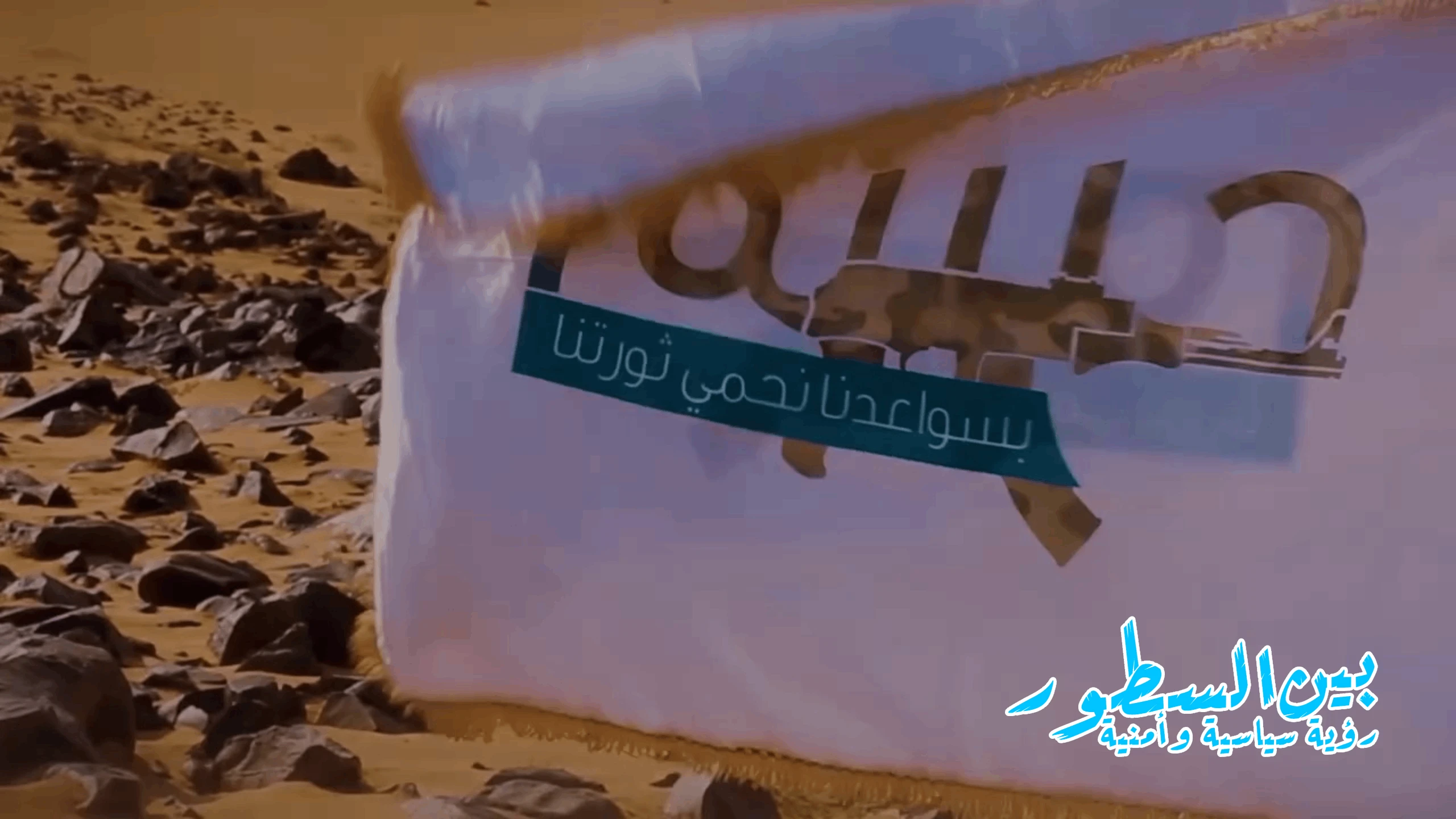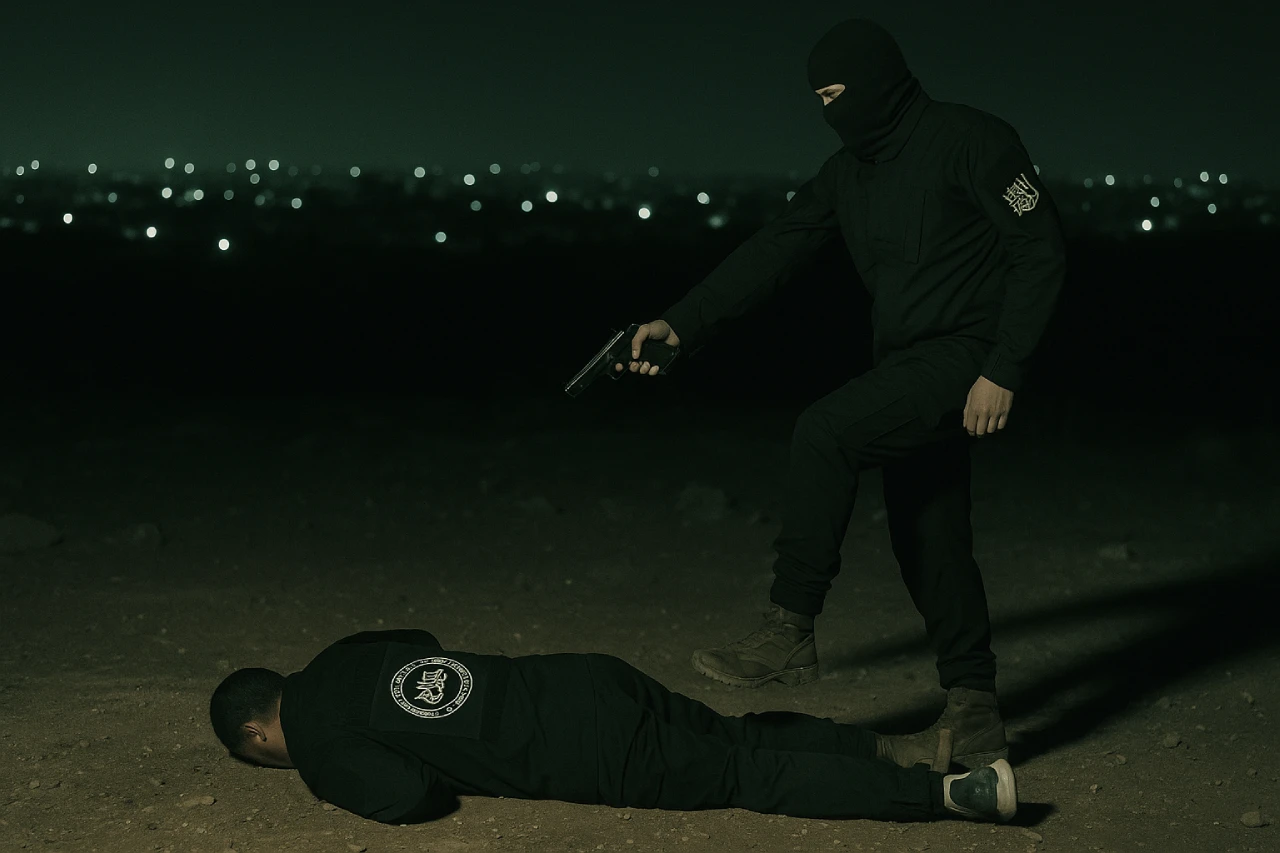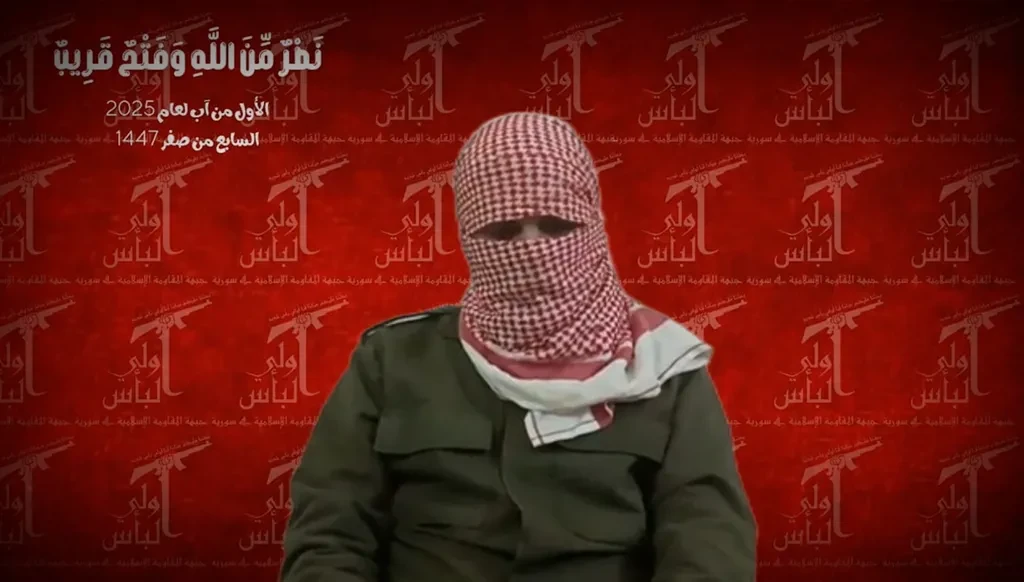Security Analysis of a Promotional Video Attributed to the "Hasm" Movement
This is an AI-generated English translation. The original text is in Arabic.
Introduction:
This analysis aims to study a promotional video attributed to the "Hasm" movement, ending with the phrase "Egypt's Hands Movement (Hasm) - Cairo," referring to the declared identity of the movement. The analysis employs a multi-level methodology to examine visual and auditory evidence, focusing on assessing the geographical, environmental, and geological characteristics of the depicted locations, in addition to analyzing the clothing, weapons, and vehicles used. It also seeks to verify the potential contexts of the videoâs filming, particularly in light of the similarities of some scenes to known conflict areas, especially in Syria. The analysis includes an attempt to answer several fundamental questions related to the nature of the video, the identity of the entity behind it, and the locations where it may have been filmed.
Analysis Methodology and Sources of Evidence:
This analysis relies on a multi-faceted methodology that ensures accuracy and objectivity, focusing on the use of open-source intelligence (OSINT) and visual analysis.
- Source of the Video: The video clip was obtained from a comment by a user on a post by the Egyptian opposition figure Dr. Ayman Nour, via his page on the social media platform "Facebook."
- Frames Extraction: To achieve a precise visual analysis of each part of the video, a code was used to convert the video into a series of still images (frames), allowing for detailed examination of each scene and the discovery of details that may be missed during streaming viewing.
- Detailed Visual Analysis of Frames: The systematic examination of the extracted frames included several aspects, such as:
- Geographical and Environmental Characteristics: Analysis of the type of terrain (desert, hills, mountains), type of vegetation (sparse or dense), colors and types of rocks, presence of water bodies if any, in addition to the shape and condition of buildings (intact or destroyed).
- Clothing and Equipment: Study of camouflage patterns in military attire, types of weapons used, vehicle models, and any modifications made to them.
- Logos and Texts: Reading and analyzing the logos and texts visible to determine their identity and implications.
- Verification and Comparative Research:
Intensive research was conducted using online search engines to find similar images and visual clues, focusing on comparing vehicle camouflage patterns in various conflict areas such as Syria. The environments depicted in the video were also compared with the known geographical characteristics of Egypt, Syria, Libya, and Sudan to assess the degree of conformity.
- Objectivity and Neutrality:
The analysis adhered to evidence-based visual and auditory data available in the video, avoiding conclusions based on speculation or political bias, and refraining from accusing any party without conclusive evidence derived from the video content itself.
Spatial, Environmental, and Geological Analysis of the Scenes:
The video reflects a clear environmental and geological diversity in its various scenes, strongly indicating that the footage was filmed in multiple geographical locations, rather than a single place. The environmental scenes can be classified into two main categories:
Desert Scenes (Repeated in the Video):
Features: These scenes are characterized by a barren desert environment interspersed with rocky hills and scattered sand dunes. The colors of the rocks vary significantly, with some appearing light-colored (gray or light brown), while others are dark and semi-spherical or convex, which may indicate ancient volcanic formations such as basalt plateaus. The colors of the sands range from light (golden or yellowish) to reddish-brown, with sparse and weak vegetation limited to dry desert grasses or scattered small shrubs.
Examples from the Video: One shot shows a group of fighters in a sandy environment, with a light-colored rocky hill in the background, while another shot depicts a fighter jumping over a rocky hill and ground covered with light-colored gravel and stones. Dark, semi-spherical rocks resembling volcanic rocks are also evident in the light desert environment.
Potential Match with the Mentioned Countries: These scenes correspond to large areas of the Egyptian Western Desert (such as the Bahariya Oasis, due to the presence of the Black Desert), or the Eastern Desert and the Sinai Peninsula. They may also match the vast Libyan desert with its diverse terrain, or Sudanese deserts such as the Bayuda Desert and the Nubian Desert. There are also similarities with parts of the Syrian Badia, especially in its southern and eastern regions, such as Hauran, known for its basalt formations, and the al-Safa hills, which were a military stronghold for jihadist fighters in Syria.
Note: It is worth mentioning that some of these scenes, especially the desert ones, may have been taken from previously filmed materials. A significant similarity has been observed between them and previous scenes that appeared in older releases of the movement, both in terms of summer attire and the accompanying desert environment, which may indicate the reuse of old visual archives.
Green Scenes with Destroyed Buildings:
Features: These scenes are characterized by dense vegetation, including green grasses and evergreen trees such as olive or pine. The terrain here is hilly or mountainous, with light-colored rocks (likely limestone or chalk) that clearly differ from the dark rocks in the desert scenes. Remains of destroyed or abandoned buildings made of light stone or traditional brick are visible, indicating a heavily affected conflict area.
Examples from the Video: Multiple shots show fighters in a green environment rich in grass and trees, with a light rocky background, while other shots depict destroyed buildings in that environment. There are close-up scenes of a fighter shooting in a grassy and light rocky area.
Potential Match with the Mentioned Countries: This environment closely matches conflict areas in northwestern Syria, such as Idlib countryside, western Aleppo, and parts of Hama and Latakia, known for their green hills, trees, and limestone rocks, in addition to the villages and stone buildings that have been destroyed due to the conflict. In contrast, these scenes do not fit the prevailing environment in Cairo or most desert areas in Egypt, Libya, or Sudan, where hilly rocky terrain and densely destroyed buildings are rare, with limited exceptions for the Nile Valley and oases that do not exhibit this topographical pattern.
Analysis of Clothing, Weapons, and Vehicles:
Clothing (Military Attire):
There is a noticeable diversity in military attire patterns among the different scenes, with some outfits leaning towards light earthy colors suitable for desert environments, while others lean towards green and dark brown colors that fit areas with dense vegetation. This diversity suggests that the fighters may be using outfits that correspond to different environments, or that the footage was compiled from multiple subgroups or different time periods.
Example: One shot shows a fighter wearing a camouflage outfit in light earthy colors with a face covering, while other shots show fighters wearing camouflage outfits in green and dark brown colors.
Weapons:
The weapons visible in the video include automatic rifles of the AK-47 (Kalashnikov) type and its derivatives, in addition to heavy machine guns of the PKM type, RPG launchers, and mortars. These weapons are widely spread in most conflict areas in the Middle East and North Africa, making them insufficient for accurately determining a specific geographical location.
Example: One shot clearly shows a fighter carrying an RPG launcher, and another shows a fighter shooting from an automatic rifle of the Kalashnikov type.
Vehicles:
The appearance of vehicles in the video reflects different usage patterns in terms of shape and camouflage, providing additional indicators about the potential operational environments. Two main types of vehicles were observed, contributing to supporting geographical hypotheses through their technical and visual characteristics.
White Toyota Hilux: A white Toyota Hilux SUV is shown, a vehicle commonly used among armed groups in desert areas due to its high durability. It appears in a close-up shot carrying a white flag with the movement's logo, moving in a light sandy environment.
Vehicle with Unconventional Camouflage: An SUV with a faded reddish-brown color is shown, suggesting heavy use or special modification. This color is not rust but rather a deliberate camouflage paint intended for concealment in specific environments or against aerial surveillance. Comparative research shows that this camouflage pattern is used by several factions in the Syrian conflict.
Example: A shot of the uniquely colored vehicle in a vegetated environment, compared to images from battles in Syria showing vehicles camouflaged in the same way in rural and barren environments.
Significance: The presence of this camouflage pattern in the video, and its similarity to documented vehicle camouflage methods in the Syrian conflict, strongly supports the hypothesis that the green scenes featuring this vehicle may have been filmed in Syria.
Analysis of Video Content (Editing, Sound, Logos):
Editing: The video shows a relatively professional production level, featuring rapid cuts between diverse scenes. This style is common in promotional videos for armed groups and is also prevalent in previous action clips to demonstrate capability and presence, but it also allows for the integration of footage from different locations to create a comprehensive narrative.
Sound: The background audio includes enthusiastic chants in Arabic, with a classical or near-classical dialect reminiscent of the chants associated with the Muslim Brotherhood and ideologically similar movements such as Ahrar al-Sham in Syria, a prevalent style in the literature of jihadist or resistance groups in the region.
Logo and Texts: The distinctive logo of the "Hasm Movement" is clearly visible in several shots, with the phrase "Egypt's Hands Movement (Hasm) Cairo" at the end of the video. The Quranic verses and other texts discussing "revolution" and "the flood of Al-Aqsa" reflect a jihadist or resistance discourse with a broader regional dimension.
Supporting Image (Hasm Movement Logo): A shot shows a white flag prominently displaying the movement's logo on the vehicle in a desert scene.
Color of the Logo and Its Significance: The turquoise or sky blue color used in the "Hasm" logo (on the white background) shows a striking color similarity with some logos used by Hay'at Tahrir al-Sham or other factions in northwestern Syria. This visual similarity, along with the use of a white background instead of black (common among organizations like ISIS and Al-Qaeda) or other dark colors, may indicate a desire to distinguish itself from those groups with more extreme ideologies, or an attempt to present a "purer" or "national" image in its propaganda discourse, or even the existence of some coordination or visual influence among factions in different geographical areas, noting that the logo has been used since the movement began to announce itself.
Answering the Main Questions:
Is it an Egyptian movement?
The identity declared in the video clearly indicates that it is "Egypt's Hands Movement (Hasm)," with a direct link to Cairo at its end. Accordingly, the movement presents itself as an Egyptian entity in terms of name and directed discourse. This is the official claim, with no direct evidence within the clip to refute it, as the movement has announced itself since 2016.
Can the clip be attributed to the original Hasm movement?
It is difficult to definitively assert the attribution of this clip to the original entity known as "Hasm Movement," especially after Egyptian authorities announced its dismantling and elimination several years ago. However, preliminary analysis of the video content may indicate a serious attempt to revive the movement, whether by new supporters or through remnants of previous leadership or elements believed to be outside Egypt â specifically in Syria or those who had previously been there according to the potential filming locations, while emphasizing that the composition of the clip from a production perspective suggests this.
Does the video resemble the production style of jihadist movements, or could it be an intelligence fabrication?
In terms of style and visual and auditory characteristics, the video closely aligns with the promotional videos produced by jihadist movements or non-state armed groups. This includes the use of enthusiastic chants, weapons prevalent in conflict areas, camouflage military attire, and showcasing training and combat operations. All these elements indicate a non-state entity seeking to demonstrate its strength and rebellious or resistant discourse.
Moreover, there is no direct visual or auditory evidence within the video supporting the hypothesis that it is a "Egyptian intelligence fabrication" or aims "for further repression." There are no government logos or elements indicating an official entity, and it closely resembles the old clips of the movement. Security analysis relies on visible evidence, and thus it cannot ascertain the political intentions of any party without clear and direct clues from the video content itself.
Was the video filmed in Syria?
It is highly likely that some scenes in the video â especially those showing a green environment, hills, and destroyed buildings â were filmed in northwestern Syria, specifically in areas such as Idlib countryside or western Aleppo.
These scenes match the known geographical and field characteristics of those areas, clearly differing from the geography of Cairo or the Egyptian, Libyan, or Sudanese deserts.
One important additional piece of evidence is the appearance of a vehicle with unconventional camouflage in a faded reddish-brown color, typically used in the Syrian conflict, which has been documented in images from battles there. Additionally, the color of the logo visible on some equipment visually intersects with some symbols of Syrian factions, reinforcing this possibility.
Are they currently in Egypt?
It cannot be definitively asserted that elements of the movement are currently present in Egypt based solely on this video, as the desert shots appear to be either old footage of the movement that has not been published before or recent clips in similar locations.
The video is a carefully curated propaganda material, and it is common in this type of production to use archival footage or to integrate scenes from different places and times. Therefore, the appearance of the name "Cairo" or the raising of the movement's logo does not constitute sufficient evidence of actual presence within Egyptian territory.
Furthermore, it is notable that the geographical environment in many of the shots, especially the green scenes, hills, and destroyed buildings, does not match any known urban or rural area in Egypt, but strongly indicates Syrian geography.
Accordingly, it is likely that the video aims to convey a symbolic or political message rather than being an accurate documentation of current field activity within Egypt.
Final Conclusion:
The video attributed to the "Hasm" movement is a produced propaganda work aimed at showcasing the movement's strength and capabilities. The visual evidence strongly suggests that the video combines footage from several diverse geographical locations. While the desert scenes may have been filmed in the deserts of Egypt or in the deserts of Libya or Sudan, the scenes showing a green mountainous environment with destroyed buildings, along with the vehicle camouflage style similar to that found in Syria, and the color of the logo matching Syrian factions, closely align with conflict areas in Syria. This clear geographical diversity undermines the implicit claim that the video reflects activities filmed exclusively in the vicinity of Cairo and indicates a propaganda strategy using footage from different environments to enhance the movement's overall message. There is no visual evidence supporting it being an intelligence fabrication, and it shows stylistic alignment with the promotional videos of jihadist or resistance groups.








.webp)